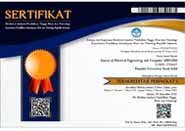Implementation of the C4.5 Decision Tree Algorithm in Determining PIP Recipient Students Based on Poverty
Authors (s)
(1) * Heri Susanto
 (Akademi Manajemen Informatika dan Komputer Taruna)
(Akademi Manajemen Informatika dan Komputer Taruna) Indonesia
(2) Dwi Yanto (Akademi Manajemen Informatika dan Komputer Taruna)
Indonesia
(3) Jamal Jamal (Akademi Manajemen Informatika dan Komputer Taruna)
Indonesia
(4) Choirul Anam (Akademi Manajemen Informatika dan Komputer Taruna)
Indonesia
(5) Thohirotun Nafisah (Akademi Manajemen Informatika dan Komputer Taruna)
Indonesia
(*) Corresponding Author
AbstractThe Program Indonesia Pintar (PIP) is a government assistance in the form of a certain amount of cash given directly to students who are vulnerable to poverty according to the established criteria. However, in its implementation, there are still many recipients of PIP funds who are still not on target. Several results of evaluations and ongoing studies on the implementation of PIP show weaknesses in this program, namely related to the accuracy of determining the target of PIP fund recipients, where it was found that there were still many non-poor households who received this PIP fund assistance. The purpose of this study is to produce a decision support system to determine students who are truly worthy of being recommended to receive PIP fund assistance. The method used in this study is the Decision Tree C4.5 algorithm. The data used were 300 datasets, by selecting several relevant attributes. For processing using the Rapidminer tool, one of the popular software used in data mining processing. Meanwhile, the evaluation method uses a confusion matrix by calculating the accuracy value. From the test results in determining PIP acceptance at SD Negeri Kedungjajang 02 using the C4.5 algorithm, an accuracy of 97.33% was obtained, with the accuracy criteria of good classification.
|
Keywords
Decision Tree; Aid Recipients; Smart Indonesia Program; Kedungjajang 02
Full Text: PDF
Refbacks
- There are currently no refbacks.
Copyright (c) 2025 Heri Susanto, Dwi Yanto, Jamal Jamal, Choirul Anam, Thohirotun Nafisah

This work is licensed under a Creative Commons Attribution License (CC BY-SA 4.0)
Journal of Electrical Engineering and Computer (JEECOM)
Published by LP3M Nurul Jadid University, Indonesia, Probolinggo, East Java, Indonesia.








